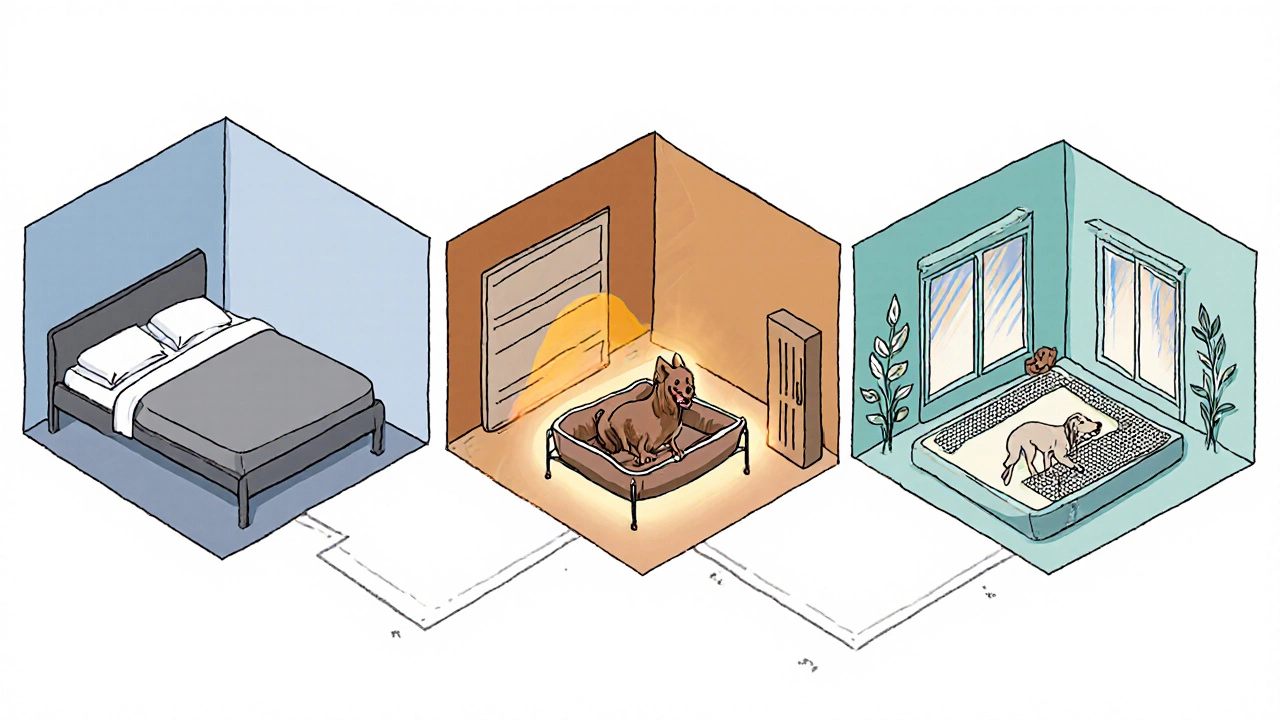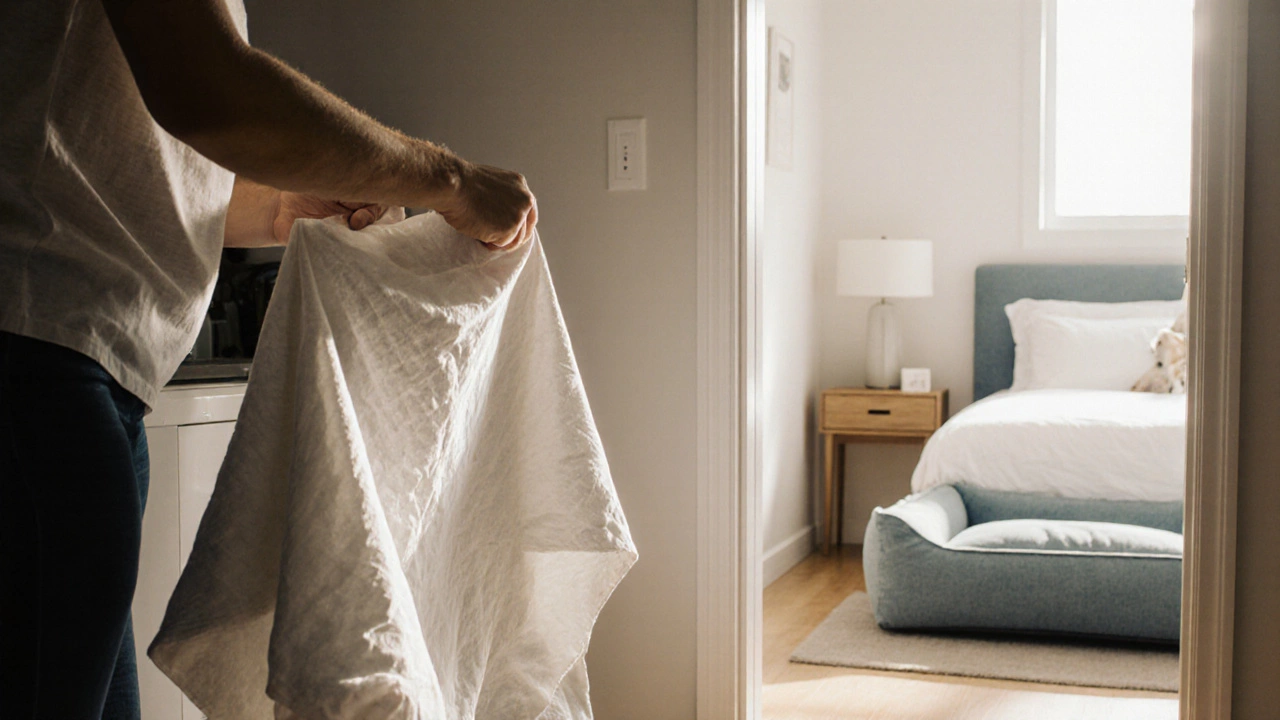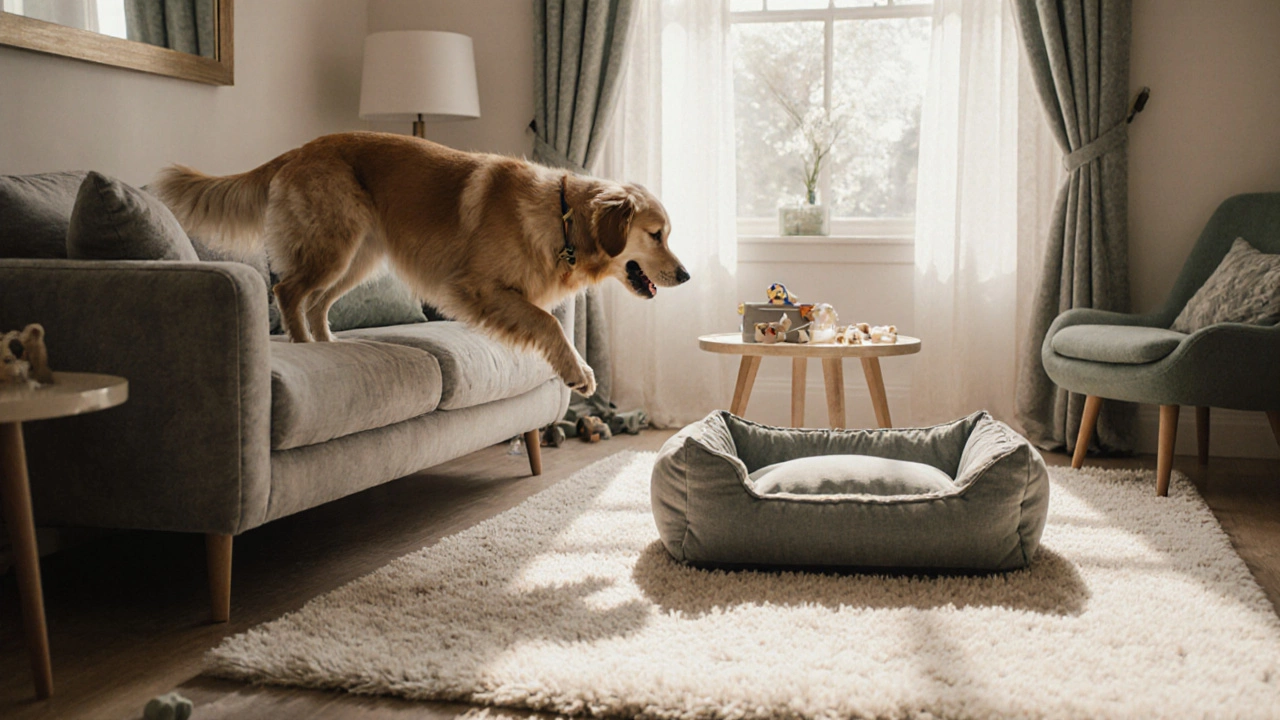Dog Bed Placement Calculator
How Many Dog Beds Do You Need?
Calculate the optimal number and placement of dog beds based on your dog's needs and home environment
Your Recommendation
When you spot your pooch hopping onto the couch, curling up on the kitchen floor, or stealing a spot on the bedroom rug, you might wonder if they need a dedicated dog bed in every room. A Dog Bed is a piece of pet furniture designed to give dogs a safe, comfortable place to rest, protect your floors, and support their health.
Key Takeaways
- Multiple beds can reduce territorial issues and keep your home cleaner.
- Consider size, health needs, and household traffic before placing a bed everywhere.
- Use portable or multi‑purpose beds for rooms you rarely use.
- Regular cleaning and strategic placement extend the life of each bed.
Why More Than One Dog Bed Might Make Sense
Dogs are naturally drawn to spots that match their comfort preferences. Giving them a bed in the living room lets them join family movie nights without stealing the couch. A bedroom bed offers a quiet sanctuary for older dogs who need undisturbed sleep. If you have a sunny sunroom or a cool basement, a dedicated bed can let them chase temperature preferences throughout the day.
From a health perspective, a proper bed can alleviate pressure on joints, especially for senior dogs or breeds prone to hip dysplasia. Having a bed close to where they eat can reduce the temptation to eat off the floor, helping maintain a tidy kitchen. Additionally, separate beds can curb resource‑guarding behaviors - a dog is less likely to bark or growl over "my spot" when multiple comfy spots exist.
Potential Downsides to a Bed in Every Room
While the idea sounds cozy, it can strain your budget and your cleaning schedule. Purchasing high‑quality beds for each space adds up quickly, and low‑cost options may wear out fast. Too many beds can also confuse a dog that prefers a single safe zone - they might waste energy hopping from one to another instead of settling.
From a hygiene angle, each extra bed is another surface that can collect mud, hair, and parasites. If you have a dog with allergies or a tendency toward skin infections, every new fabric piece introduces another place for allergens to gather. Finally, beds can interfere with interior design if not chosen carefully, making your home look cluttered.

How to Decide Where and How Many Beds Are Right
- Assess your dog’s size and health. Larger breeds need bigger, sturdier beds. Seniors or dogs with arthritis benefit from an Orthopedic Dog Bed that cushions joints.
- Map out high‑traffic areas. Identify rooms where you spend most time - living room, kitchen, bedroom - and consider a bed nearby.
- Consider temperature zones. A Heated Dog Bed works wonders in colder rooms, while a breathable mesh bed suits sunny spots.
- Factor in cleaning routines. If you’re diligent about vacuuming and washing, more beds are manageable. Otherwise, limit to essential rooms.
- Watch for anxiety triggers. Dogs with separation anxiety often seek proximity to owners. Placing a bed in the master bedroom can provide reassurance without needing constant supervision.
Types of Dog Beds and Best Placement Tips
| Bed Type | Ideal Use | Key Features | Best Room |
|---|---|---|---|
| Standard Foam Bed | Everyday lounging | Lightweight, washable cover | Living room, bedroom |
| Orthopedic Foam Bed | Senior or joint‑issue dogs | Memory foam, extra support | Bedroom or quiet nook |
| Heated Bed | Cold climates, short‑haired breeds | Built‑in low‑watt heating element | Garage, basement, or drafty rooms |
| Portable Travel Bed | On‑the‑go, occasional use | Foldable, compact, water‑resistant | Guest room, patio, car |
| Elevated Mesh Bed | Hot, humid environments | Airflow underneath, easy to clean | Sunroom, kitchen floor |
When you pick a bed, match its features to the room’s climate and your dog’s routine. A portable travel bed can double as a guest‑room option for visiting dogs, saving you from buying a permanent piece you’ll rarely use.
Step‑by‑Step Guide to Setting Up Beds in Multiple Rooms
- Start with the essentials. Place a high‑quality standard foam bed in the room you and your dog share most often.
- Test the layout. Let your dog explore the new spot for a few days. If they ignore it, move it closer to a doorway or a favorite window.
- Add a specialty bed. If your dog is older, add an orthopedic bed in the bedroom where nighttime rest happens.
- Consider temperature. In colder months, set up a heated bed in the garage or basement where they like to nap.
- Use portable options. For rarely used rooms, keep a foldable travel bed stored in a closet. Pull it out when you expect guests or when you rearrange furniture.
- Establish house rules. Train your dog to stay off sofas or chairs if you want the beds to be the primary sleeping spots. Consistency reinforces the new habit.
- Maintain hygiene. Wash removable covers weekly, vacuum underneath, and rotate mattresses to prevent sagging.
These steps keep the process manageable and prevent you from overspending on beds you never use.

Cleaning, Hygiene, and Health Considerations
Dog hygiene is a big factor when you multiply sleeping surfaces. Here are practical tips:
- Choose removable, machine‑washable covers. Materials like microfiber or polyester hold up to frequent laundering.
- Vacuum weekly. Even with covers, hair and dander settle into the foam core.
- Spot‑treat stains. A mix of equal parts water and white vinegar neutralizes urine odors without harsh chemicals.
- Check for parasites. Inspect each bed for fleas or ticks, especially after outdoor trips.
- Rotate beds seasonally. Swap a heated bed for a cooling mesh bed as the weather changes to keep your dog comfortable year‑round.
Keeping each bed clean reduces the risk of skin irritations, allergic reactions, and the spread of germs throughout your home.
When Fewer Beds Might Be Better
If your dog is a lone wolf who prefers a single den, or if you have a tiny apartment, one high‑quality bed placed strategically can meet all needs. In multi‑dog households, too many beds might lead to competition; instead, assign each dog a personal bed in separate zones.
Also, if you’re on a strict budget, invest in one premium orthopedic or heated bed and use a cheap washable blanket as a secondary spot. This approach balances comfort with cost.
Frequently Asked Questions
Do dogs really need a separate bed from our own?
A dedicated dog bed gives them a clean, supportive surface, reduces hair on human bedding, and can help with joint health. It’s not mandatory, but it’s a big quality‑of‑life upgrade.
How many beds is too many?
If you find yourself buying more than three beds for a single dog, you’re probably overdoing it. Focus on high‑traffic rooms and health‑specific needs instead of covering every doorway.
Can I use a regular human pillow for my dog?
Pillows lack the supportive foam needed for a dog’s joints and can become a breeding ground for bacteria. Stick to beds designed for canine weight distribution.
What’s the best material for a dog bed in a hot climate?
Elevated mesh beds made of breathable fabric keep air circulating underneath, which helps lower body temperature during summer months.
How often should I wash my dog’s bed?
Aim for a weekly wash if the cover is removable. If the bed has a non‑removable core, spot‑clean it regularly and replace the cushion every 12‑18 months.
Whether you go for a bed in every room or stick to a couple of strategic spots, the key is matching comfort, health, and practicality. Your dog will thank you with more relaxed naps, and your home stays cleaner.

